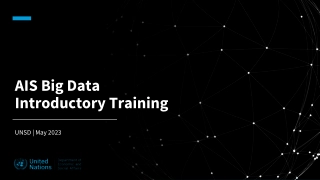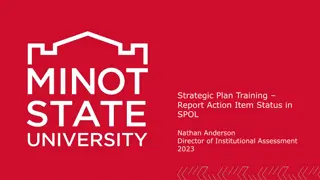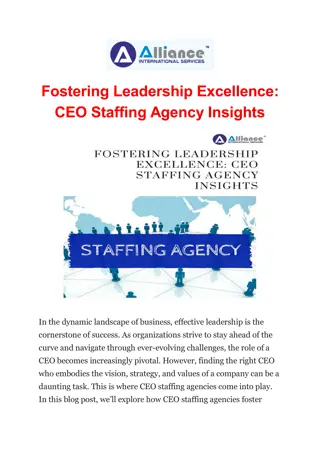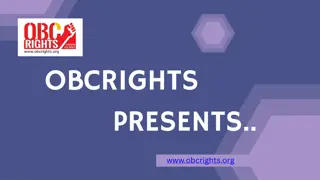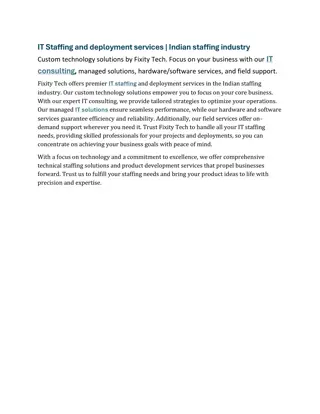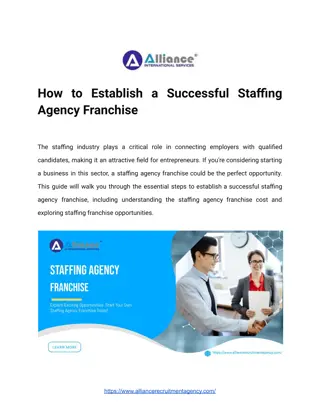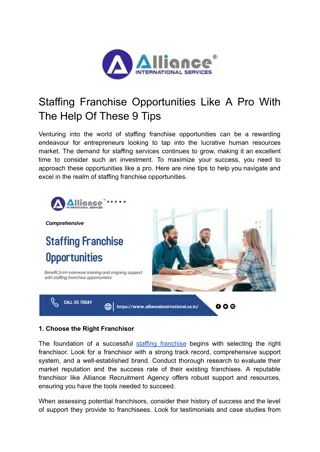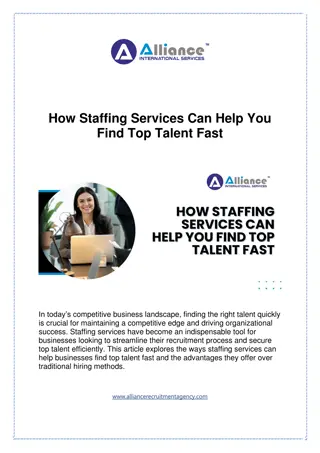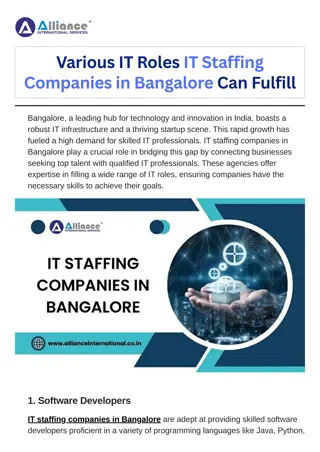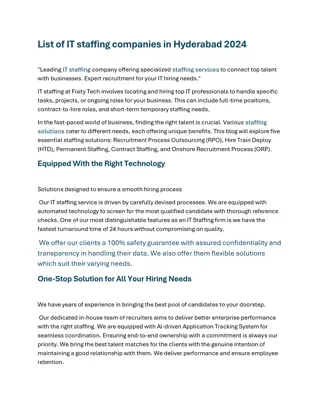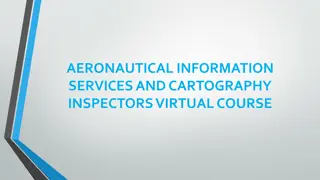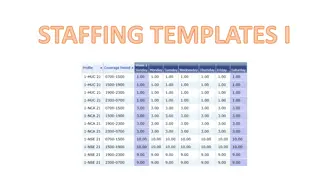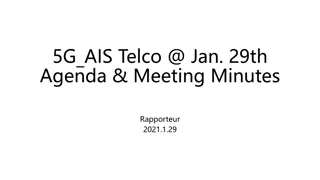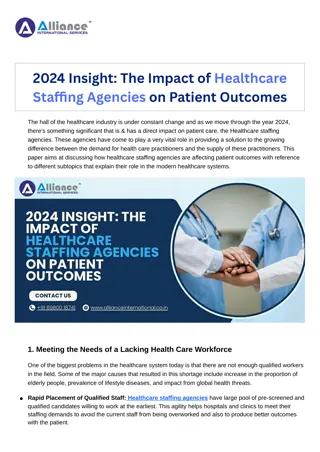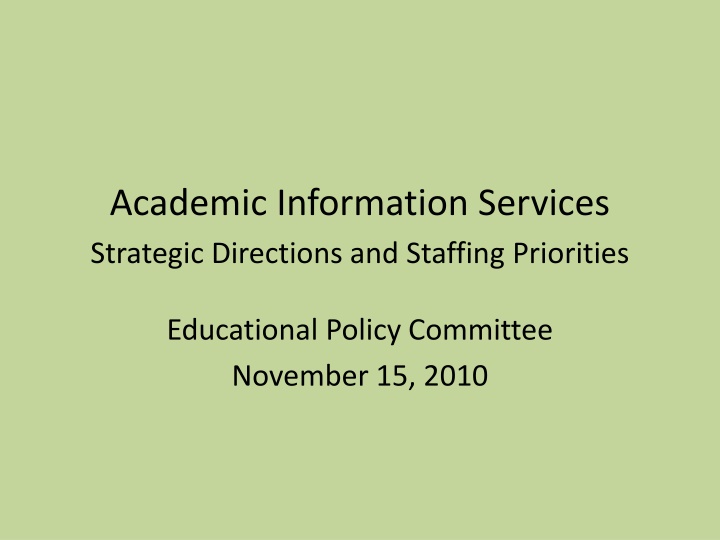
Strategic Directions and Restructuring in Academic Information Services
This document outlines the strategic directions, historical context, facilities' evolution, recent restructuring, and future plans of Academic Information Services (AIS) within an educational institution. It covers the transition from Olson Library to AIS, changes in staffing and facilities, and the recent shift towards Instructional Design and Technology. The restructuring impacts facilities use, budget allocation, and staffing changes, emphasizing a move towards a more streamlined and efficient structure.
Download Presentation

Please find below an Image/Link to download the presentation.
The content on the website is provided AS IS for your information and personal use only. It may not be sold, licensed, or shared on other websites without obtaining consent from the author. If you encounter any issues during the download, it is possible that the publisher has removed the file from their server.
You are allowed to download the files provided on this website for personal or commercial use, subject to the condition that they are used lawfully. All files are the property of their respective owners.
The content on the website is provided AS IS for your information and personal use only. It may not be sold, licensed, or shared on other websites without obtaining consent from the author.
E N D
Presentation Transcript
Academic Information Services Strategic Directions and Staffing Priorities Educational Policy Committee November 15, 2010
Strategic Planning On a continuum some things happening now have been on AIS plan even before there was AIS (i.e., when identity was Olson Library) Components include: Services Facilities Staffing Budgets Documents include: Mission statements Strategic plans NMU Road Map to 2015 Policies Outcomes assessment EPC criteria
Context A Brief History Olson Library + Instructional Media Services + Central UP & NMU Archives + Academic Computing Services + Instructional Technology & CITE = AIS Most of these changes transpired in late 1980s and early 1990s
Facilities Learning Resources Center (LRC) Original design Library on 3 floors, Learning Resources Division on 1 floor Faculty offices on 1stfloor temporary = 25 years Various renovations brought in Academic Computing Services (HelpDesk, Micro Repair), computing labs, distance education classroom, faculty offices (again but temporary = 2 years), expanded food service (Fieras and Starbucks), All Campus Tutoring, Writing Center
Recent Restructuring AIS/Academic Computing Services AdIT Programmers moved from ACS to AdIT Micro Repair moved from ACS to AdIT HelpDesk remains with AIS Instructional Media Services (IMS) and Instructional Technology become Instructional Design and Technology
Recent restructuring impacts Facilities use vacant ACS offices becoming Instructional Design & Technology (fulfilling a 20+ year goal to move IMS to first floor) Budget shifts Staffing changes Mission statements - revisions
Instructional Design and Technology 5 years ago began process of revamping Instructional Media Services and Instructional Technology (including CITE) Retirement of Reference/Media Services Librarian Reallocated funds to create two positions: Reference/PreK-12 Librarian (term) and Director of Instructional Design, Technology & Media Now finalizing restructuring to IDT
AIS Mission Statements AIS Mission Statement Academic Information Services supports teaching, learning, scholarship, and community outreach activities by providing information resources, access to educational technology, and instructional services to help students and employees acquire information and technology skills that contribute to lifelong learning and productive citizenship. (Accepted by AIS Dean s Advisory Council; 3/19/09) AIS Unit Mission Statements Archives revised 3/19/09 Computing HelpDesk revised 10/5/10 Instructional Design & Technology revised 10/18/10 Lydia M. Olson Library revised 3/19/09
EPC Criteria Align with Mission & Vision of Academic Affairs Intellectual Foundation Instructional services focus on critical thinking, problem-based learning Liaisons with depts, English (EN111), FYE, Writing Center Archives cultural, historical, local & regional EduCat, instructional technology Active Learning Credit courses complement broader curriculum (Liberal Studies, Public History) Student employment Career Preparation Student employment leading to graduate school or employment Resources for exploring career options Community Engagement Connections to regional K-12, Charter Schools, Native American schools/libraries Local library connections Peter White Public Library Archives internships
EPC Criteria (cont.) History, development, and expectations Why To support students and faculty Evolution Changes within AIS organization Use of technology, digital resources Growth in student employment opportunities Continual adaptation to changing environment External demand Resource sharing Student employee placement from all AIS units Regional and state partnerships Libraries, Historical societies & museums MERLOT, SLOAN-C, ELI
EPC Criteria (cont.) Internal demand Does AIS provide essential support for others in the University? Yes. Quality of program inputs and resources Equipment maintained, updated, replaced (e.g. EduCat, software, digital resources equipment) Facilities recent improvements; on renovation list, tentative plan incorporates ASNMU interests Faculty expertise, engaged Students hiring matches our expectations of professionalism, customer service, cooperation
EPC Criteria (cont.) Quality of program outcomes Student employees in graduate school and jobs related to AIS employment Faculty & staff productivity Involvement in state, regional, national organizations MI Library Association Board of Directors, conference planning, conference proposal review MI Council of Library Deans subcommittees on Collection Development and Interlibrary Loan/Resource Sharing American Library Association Popular Culture Association, with literature connection Michigan Archival Association Scholarship Articles, presentations, development of national standards for Archives NACO, SACO national recognition
Quality of program outcomes (continued) Impact on regional community Tribal libraries consultations Geographic mapping for Peter White Public Library MeL e-Library trainer for local libraries Archives workshops on preserving local documents, family histories Learning outcomes assessment AIS 101 ongoing component of Library s assessment
EPC Criteria (cont.) Size, scope, and productivity of the programs Library measures as reported in Academic Library Survey (formerly IPEDS) (FYES: FTETF Library Fac is 981:1) Archives collections and acquisitions political, economic, government records and papers Computing HelpDesk questions exceeded 33, 500 for FY10 Instructional Design & Technology EduCat requests exceeded 1,000 in Fall 2010 semester
EPC Criteria (cont.) Revenue and other resources Grants Archives MI Humanities Council ($32,000) Nat l. Historical Preservation & Records Commission Instructional Design & Technology NSF grant partnering with STEM disciplines (pending, between $160,00 -- $200,000) Library Japan Foundation materials grant ($3,500) MI partner is LSTA grants for digital resources ($250,000+) After use revenue Better World Books for withdrawn library books (69% to BWB)
EPC Criteria (cont.) Costs, expenses associated with AIS $3.5 million general fund Established labor, student labor Library Acquisitions Equipment & computer systems Efficiencies and cost cutting Shared purchasing through Midwest Consortium Library Services Open source software adoption (e.g., EduCat, Shiboleth, etc.) Access rather than ownership Combined service point (Library Circulation + Reference) Digital instructional tools for EN 111, UN100
EPC Criteria (cont.) Impact, justification, and overall essentiality Opportunity analysis, including collaborative relationships These factors are articulated within strategic directions documents, outcomes assessment plans, resource and services use data, and instructional data Factors are evaluated on an ongoing basis
Library Strategic Directions 2009-2015 Based on David W. Lewis, A Strategy for Academic Libraries in the First Quarter of the 21stCentury, College & Research Libraries (2007) Adapted to NMU environment Affects physical facility Involves all AIS units, particularly Archives which has a long standing collaboration with Library Reflects shifts in needs of students & faculty; local use patterns; changes in publishing; multiple methods for delivering services and resources; and regional, state, and national partnerships Impacts staffing plan and budget priorities
Five Library Strategic Directions 1. Continue the migration from print to electronic collections and capture the efficiencies made possible by this change. 2. Retire legacy print collections while maintaining discipline-based core titles and preserving access to resources. 3. Redevelop the library as the primary informal learning space on campus and continue to develop partnerships with other campus units that support research, teaching, and learning. 4. Reposition library expertise, resources, and information tools so they are embedded into the teaching, learning, scholarship, and research enterprises. 5. Migrate from purchasing materials to curating content.
Steps taken toward fund capture for reallocation and/or meeting budget reduction targets Past Internal Reallocations (historical view) Librarian in Technical Services to Reference/Instruction Reference Secretary (TOP) to Senior Library Assistant Most Recent HelpDesk Consultant (TOP) Ref/Instruction/Pre-K-12 (Fac/Term) 12 month to 9 month Sen. Library Asst. (TOP) Post MLS Fellow (Fac 2/3) Director of ACS Reference/Web Librarian (Fac) 12 month to 10 month 12 month to 11 month vacant, on hold position eliminated voluntary furlough (2.17 FTE + furlough)
Reallocation dollars Staff changes offer some opportunity for internal reallocations to growth areas A portion of captured dollars directed toward budget reduction targets, e.g. Director of ACS position elimination used to (a) meet AIS share of Academic Affairs reduction and (b) achieve President s target of $375,000 in restructuring AIS and AdIT; currently working with Finance & Administration to determine remaining funds
AIS Staffing Plan 5-year rolling plan Two components Current positions changes, vacancies New/modified positions (reallocations) Both components need to fit missions, AIS strategic plans, NMU Road Map, budgeting plans (AIS, Academic Affairs, NMU)
AIS Staffing Plan Current Positions Senior Library Assistant (TOP) filled but reduced to .92 FTE (initial savings: base salary of new employee vs. 44 year employee + FTE reduction) Library Cataloger (Fac/TE) advertised; position revised as Cataloger/Metadata in keeping with Library Strategic Directions (initial savings: base salary of Asst Prof vs. 40 year Prof) Post MLS Fellow (Fac 2/3) vacant; on hold but have recommended filling; consistent with strategic directions; non-renewable 2-year term; funding reserves tapped if needed (one time funding) Instructional Media Services Supervisor (AP) pending retirement (01/11); reconfigure to bridge Instructional Media Services and Instructional Technology; service hours exceed 5 days/week and 8 hours/day
AIS Staffing Current Positions (continued) Restructuring of Instructional Design & Technology unit plus upcoming retirement has necessitated the review of 3 positions: o Instructional Technologist o Instructional Media Services Supervisor o Redesigned IMS Supervisor (retirement position) Worked with Human Resources o Matched with O-Net o Matched with CUPA
AIS Staffing: Adjustment of Previous Decision Computing HelpDesk Consultant (TOP) reduced to 10 months; discovered this is not working well Recommended increase to 11 month appointment Low financial impact, but gain improved service Cost $3,790 Funding source savings from Senior Library Assistant change from 12 to 11 months More than 33,500 HelpDesk interactions in FY10
AIS New/Modified Positions Reallocations Priority 1 Instructional Technologist (AP7) Top priority for past 3 years in AIS staffing plans Growth in use of course management system Assist faculty with design and construction of web-enhanced, hybrid (blended), online courses and programs Design team environment Exploration of emerging technologies Funding possibility resulting from elimination of Director of Academic Computing Services Road Map to 2015 - Meaningful Lives and Leveraging Campus Attributes
AIS Reallocations Positions (cont.) Priority 2 Archives/Records Management Specialist (anticipated to be AP4) Ranked as 2ndor 3rdpriority in last 3 years AIS staffing plan Support required for NMU records retention & destruction, both print and electronic (350-400 cubic feet of print material annually using 350 state approved retention schedules) Assist with NMU institutional repository Fund partially with difference in Cataloger/Metadata position; partially from Academic Affairs Consistent with Library Strategic Directions and NMU Road Map
AIS Reallocation Positions Priority 3 AIS Documentation & Web Support (anticipated to be AP5) Ranked 3rdor 4thin past 3 AIS staffing plans Combined two proposed positions in light of recent restructuring Support for Library, HelpDesk, and Instructional Design and Technology Instructions, policies, procedures for communicating the potential, the limitations, and the legal obligations of resources, software, hardware, network applications used campus-wide for classes, research, and presentations Web-based and mobile Funding reallocation from outside AIS if done now or from possible future reallocations Connections to Library Strategic Directions and NMU Road Map
Conclusion Staffing positions are one of the building blocks in a process to sustain and enhance the most appropriate, productive, and effective AIS services (i.e. programs) Also in the works: A fiscal plan to seek ongoing support for Library acquisitions that is consistent with the strategic plan Revisions to the LRC program statement and renovation plan that incorporate AIS changes with selected features sought by ASNMU Equipment and renovations to support a high-tech interactive classroom and a redesigned CITE (partial funding from NSF grant if awarded) Plans for relocating Archives onto the LRC 3rdfloor External review of Library materials associated with the Holocaust and Human Rights to ascertain collection strengths Targeted opportunities for staff professional development, particularly for our TOP and AP employees, to enhance skills and knowledge and thus improve services and morale Increased involvement with information literacy and embedded librarianship Feasibility analysis for providing HelpDesk and basic Archives support at the newly configured Public Services desk

